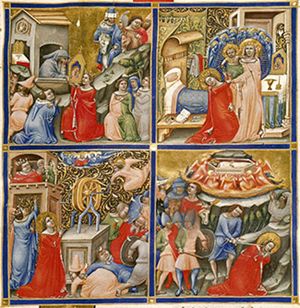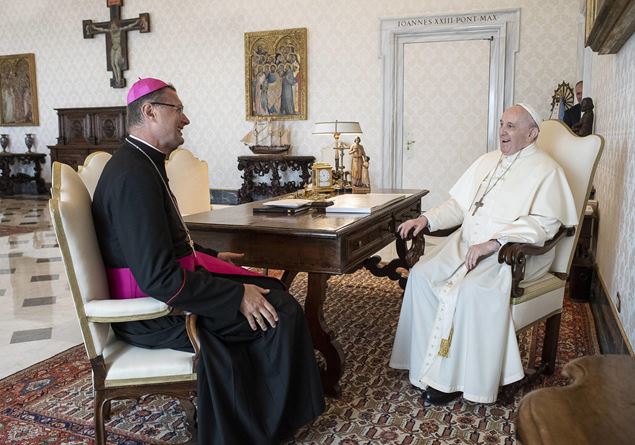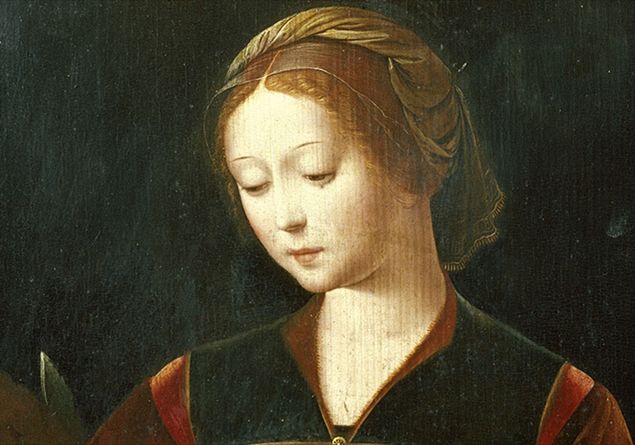According to tradition, Catherine, a noble, beautiful and cultured young Christian, was martyred in 305 in Alexandria, Egypt, the center of ancient cultures and capital of the Christian wisdom tradition. The late texts with the story of his life and martyrdom are a Greek Passio from the 6th-7th century probably written for edifying purposes by a cleric from Alexandria or a monk from Sinai, and a Conversio perhaps from the 8th century. His martyrdom dates back to the time of Maxentius, or Maximinus, who harshly persecuted the Christians. On the occasion of a great sacrificial celebration to the gods desired by the emperor, Catherine, refusing to join, addressed the sovereign thus: “Why do you want to lose this crowd with the cult of the gods? Learn to know God, creator of the world and his Son Jesus Christ who with the cross freed humanity from hell.”
The wise men summoned by the emperor converted
The emperor, struck by such firmness and determination, summoned her to be convinced by the reasoning of his rhetoricians and philosophers, which however were refuted by the wisdom of the young Christian; the wise men converted and for this they were burned alive. The sovereign attempted to seduce her with the offer of illustrious marriages and riches, but received only refusals; he therefore had her imprisoned; in prison she was fed by a dove and Christ himself visited her. It was also visited by the empress and the head of the court who, struck by Catherine’s words, converted with 200 soldiers. The emperor then had her subjected to the torture of pointed wheels: but the intervention of an angel saved her, while the broken wheels hit many soldiers. The empress herself, who declared herself Christian, was subjected to torture and beheaded. Death by decapitation was also decreed for Catherine: while her head was severed, milk flowed from her neck and the angels immediately transported her body to Mount Sinai, where she was buried. From Conversio we have other news about the royal origins and the “mystical marriage” of Catherine with the Child Jesus, presented to her by the very arms of the Virgin, of which the saint saw on the first night after her baptism: fact and circumstances which recall, through the categories symbolic of specific literary genres, messages of authentic Christian values. This episode, due to its suggestion, was illustrated many times in the iconography of the saint. Many clichés typical of hagiography are evident in these texts, however the figure of Catherine is perceivable beyond the literary guise and brings us an image of a woman that correlates with an existing character, whose real historical data have been lost within the legendary tale.

The angels carry his body to Mount Sinari
Catherine’s life is full of symbolic messages: it is said, for example, that the angels transported her body to Mount Sinai where, later, a famous monastery arose, still existing, a destination for pilgrimages, known as a place of great thaumaturgy performed through the milk and oil that flowed from the saint’s tomb. Catherine is presented in the hagiographic texts, rich in details, and in the cult tradition as the personification of the victory of Christianity over the cults and culture of the pagans. Of great importance is Catherine’s multiple testimony: virgin, martyr, wise and high-ranking woman, aspects and values that characterize very specific moments of the expansion and affirmation of Christianity. The cult of Saint Catherine appears to have been brought to the West by Eastern monks and was certainly widespread after the Crusades. The devotion, which had great expansion, confirmed over time by a rich iconography, present in many expressions of popular religiosity, has among the oldest evidence a painting from the 8th century in a chapel of the basilica of San Lorenzo all’Agro Romano, where the martyr is portrayed near the throne of the Madonna. Another contemporary testimony is found in the catacombs of San Gennaro in Naples. Liturgically Catherine is celebrated in the Menologium of Basil II (976-1025); in the 10th century there are testimonies in Montecassino; finally, liturgical books give strong evidence of worship throughout Europe, especially starting from the 12th century.

The monastery of Saint Catherine on Sinai, built in the 6th century on the place where, according to legend, the martyr’s body was carried by angels.
A huge cult especially in intellectual circles
In France the main place of worship was the Benedictine monastery of La-Trinité-au-Mont, where, in the first half of the 11th century, the relics of the saint were brought, highly venerated for the healings that took place there. There are many buildings of worship dedicated to her in Italy, and there is also a strong presence of toponyms that remember her throughout Europe. There were many patronages granted to Catherine: the one over theologians and philosophers was important; therefore it was much venerated in cultured circles, playing an important role in the Christian tradition, in the life of religious orders, first of all the Benedictines, in the history of universities and studies. The Sorbonne elected her patron, and the students of the Parisian university venerated her in a church named after her. The mendicant Orders, characterized by a strong attention to science and culture in various disciplines, chose her as the patroness of studies and cultural centers, spreading her cult throughout Europe. The Augustinians stood out in this particular devotion, and there are many works that document their profound devotion. November 25th was considered, in the religious houses of study, the solemn day of the feast of studies, in which the saint was also celebrated with “academies” (on the model of the older theologica disputatio which was held on this occasion) in which professors and students, in the presence of a qualified audience, gave evidence of their knowledge in various fields of culture. The story, combined with the personal and cult characteristics of the saint, was very present in popular culture, making her the protagonist of narratives, sacred representations, popular songs, which spread her knowledge and fame. In many regions of Europe, his festival took on the character of a celebration for youth, with its own rites and events; Catherine was the patron saint of unmarried girls, sailors and some categories of craftsmen, such as wheel builders and seamstresses, who in some places in Northern Italy are called “caterinettes”. The suggestive ideas contained in the hagiographic texts were received and illustrated in various ways by a vast iconography dedicated to the young woman from Alexandria, always characterized by iconographic attributes: the crown, the book of the wise woman, the wheel and the palm of martyrdom.









